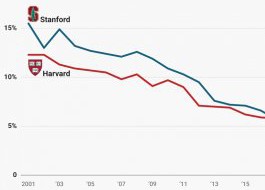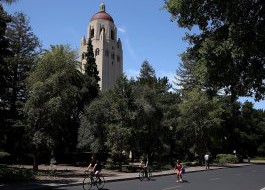
There’s an easy solution to the problem of finding a great higher education at an affordable price. Just go to Harvard.
Sure, hardly anybody has the grades, overstuffed extracurricular schedule, or parental connections to get in. But Harvard — where annual tuition, room, board, and fees clocks innorth of $60,000— is actually an incredible deal.
That’s because pretty much no one pays full sticker price. According to updated data released earlier this month on the 2014-15 academic year by the U.S. Department of Education, the average net price — what people actually pay, accounting for expenses and financial aid — was only $14,000.
The price is lower if you come from a middle-class family. Families earning between $30,000 to $75,000 a year typically paid only a little more than $5,000, according to the Education Department.
The same goes for almost all the top schools. The average net price for middle-class families at Stanford was a bit more than $6,000. Princeton? Roughly $5,000.
Meanwhile, annual earnings for a typical Harvard grad are $68,900 six years after graduation. Stanford grads six years out? An astronomically high $71,000. Schools offering relatively low prices for middle-class families and high earnings after graduation cluster at the upper left in the chart below, where we looked at costs and earnings for students at roughly more than 700 public and private colleges and universities in 2015.

The bottom right is reserved for expensive schools where students don’t earn much when they graduate. You don’t have to be Sherlock Holmes to notice that a lot of them are art schools. We emailed representatives of the schools we named. Pratt Institute’s provost, Kirk E. Pillow, sent us a statement noting that teacher expenses tend to be much higher at art schools due to small class sizes and low student/faculty ratios.
“While graduates from art and design schools may not always yield the highest salaries compared to high-paying fields like medicine, business, law, and engineering, students who follow their creative passion reap rewards that can’t be quantified in a paycheck,” Pillow said.
Berklee College of Music President Roger Brown has argued that the Federal data on colleges—known as the College Scorecard—unfairly stigmatizes art schools.
“The Scorecard takes a flawed, one-size fits all approach,” he told us in a statement.
They make some good points. This is an admittedly simple way of looking at things. College isn’t just about how much it costs and how much you get paid when you’re done.
Still, if you’re going to be taking on the kind of debt that comes with a college degree today, you’re wise to take a cold, hard look at the numbers.
Read the original article on VICE News. Check them out on YouTube, Facebook, and Instagram. Copyright 2016. Follow VICE News on Twitter.




